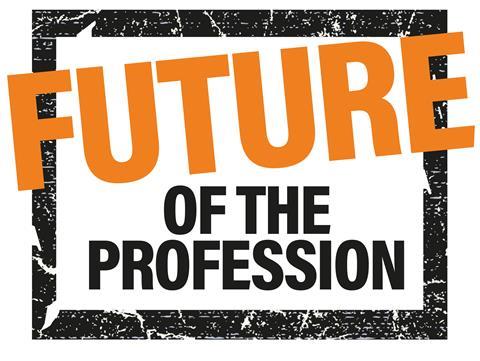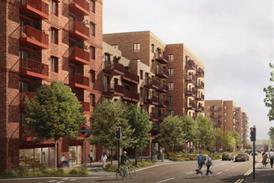The Level 7 architecture apprenticeship has opened doors for many aspiring architects. Karen Mosley explains why cutting its funding sends the wrong message about access

The government’s decision to remove funding for Level 7 apprenticeships, including the final stage of qualification for architects, is a deeply regressive move. One that threatens to quietly dismantle a vital route into our profession, a profession which is on the shortage occupation list.
The Level 6 and 7 architecture apprenticeship pathway has been a quiet success story, steadily growing in numbers over the past seven years. It has removed traditional barriers, broadened access, and allowed students to remain embedded in practice. This structure has enabled apprentices to draw on real-time industry experience while developing the academic and practical skills for navigating the growing complexities and responsibilities of our profession.
And for many, it has provided the only viable route to becoming an architect, without incurring significant debt, leaving employment, or dropping out entirely. The apprenticeship route is addressing all of this for architecture.
It’s impossible to square the decision with the government’s ambitions for sustained growth. If we are serious about boosting our economy, creating the infrastructure for individuals to thrive, and going some way to delivering the ambitious targets set, we need a skills system that supports progression from entry-level roles through to the highest levels of professional competence, that will deliver good design to maximise all the investment made.
Level 7 isn’t an optional add-on, it’s essential for an architect to qualify, necessary for registration with the Architects Registration Board. If apprentice numbers fall and courses close, where does that leave Level 6 or other feeder pathways when the top rung of the accessible ladder has disappeared? Wind back further upstream and the decision also undercuts the broader ecosystem of outreach and aspiration-raising initiatives aimed at diversifying our profession and raising education standards.

Across the UK, architects work closely with schools to broaden participation, especially in areas of low social mobility, opening young eyes to careers in architecture and showing that the built environment is exciting and accessible. What do we tell these students now? That architecture is for them, as long as they can afford it? That the door is open, but only part way?
If we’re truly committed to raising aspirations and social mobility, we cannot invite young people to dream big while seeing the funded pathways being dismantled that make those dreams achievable. The contradiction is just so stark.
On the one hand, a call for breaking down barriers to opportunity, a skilled workforce, innovation, growth. On the other, the removal of the very mechanisms that deliver precisely that.
It’s a short-sighted move by government with far-reaching consequences. And this doesn’t just impact architecture, but other critical sectors where shortfalls in skills and jobs need to be addressed to get the public sector working more efficiently, such as healthcare and town planning.
The architecture apprenticeship is a model of how things should work
It’s frustrating that this decision seems driven by concerns about misuse of the apprenticeship levy, particularly funding for senior leadership courses. Reform may be needed, but let’s not forget, we also need better senior managers and leaders too. Leadership matters in shaping innovative and inclusive businesses that provide good and sustainable jobs. Learning never ends.
What’s most demoralising is the lack of stability and vision, the constantly shifting sands of education and funding that make long-term progress so incredibly difficult. If the government truly wants to strengthen links between education and industry and bring businesses right to the heart of their growth mission, as it claims, it must take the time to truly listen to what is happening, to the needs of our sectors, and preserve what’s working.
This decision could undo years of collaborative effort between educators, practices, institutions and regulators.
Our sectors must stay united on this, collectively calling for funding to be reinstated and gaining clarity on how the smarter use and deployment of the new Growth and Skills Levy will support our needs now and into the future.
The architecture apprenticeship is a model of how things should work. Defunding it will be a costly mistake, one that wastes so much time, talent, potential, and erodes the very future we are trying to build.
>> Also read: Architecture apprenticeships under threat as Level 7 funding withdrawn for over-21s
>> Also read: RIBA slams cut to apprenticeship funding for over 21-year-olds
Trailblazer Group
Architecture apprenticeships were created by a Trailblazer group of practices, supported by RIBA and the ARB. The group included:
Foster + Partners (lead employer), Allford Hall Monaghan Morris, ARUP, BDP, Bowman Riley, Faulkner Browns, Feilden Clegg Bradley Studios, Grimshaw, Hawkins\Brown, HLM Architects, HOK, Honey, HTA Design LLP, Lipscomb Jones Architects, Perkins + Will, PLP Architecture, Pollard Thomas Edwards Architects, Purcell, RH Partnership, Ryder Architecture, Scott Brownrigg, Seven Architecture, Stanton Williams Architects, TfL, tp bennett.
Postscript
Karen Mosley is Social Impact and Inclusion Director at HLM Architects.
















3 Readers' comments